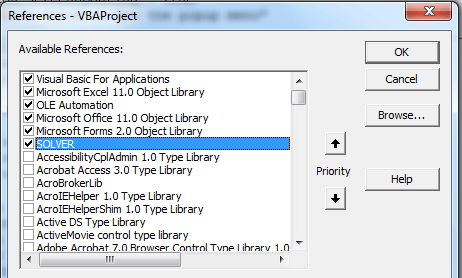Excel Solver using VBA macro
Nelson-Siegel Yield Curve Fitting
We use Excel solver to get a solution of non-linear least squares problem. I take my favorite model, Nelson-Siegel model, as an example,
As can be seen in the above figure, a term structure of yields is fitted with initial guesses for parameters. we need to estimate these 4 Nelson-Siegel parameters (b0, b1, b2, lambda).
VBA editor ➔ Tools ➔ References ➔ Solver
To use Solver in VBA macro, Go to Tools ➔ Reference in Visual Basic Editor menu. From the references list, choose “Solver” and click on Ok to use it.
Some Excel Formula
There are three block of Excel formula : RMSE (B4), b0+b1 (G4), fitted yields (D7~D20).
RMSE (B4) is a square root of mean of fitting errors. Curly braces denotes CTRL+SHIFT+ENTER as you already know.
|
cell B4 ⇒ {=SQRT(AVERAGE((C7:C20-D7:D20)^2))} |
b0+b1 (G4) is sum of b0 and b1, which means a short-term rate is not negative although this is not the case for some European country. It depends on which country's yield curve is used.
| cell G4 ⇒ = C4+D4 |
Nelson-Siegel fitted yields (D7~D20) have its excel formula as follows.
|
cell D7 ⇒ = C4+D4*(1-EXP(-F4*B7))/(F4*B7)+E4*((1-EXP(-F4*B7))/(F4*B7)-EXP(-F4*B7)) ... cell D20 ⇒ = C4+D4*(1-EXP(-F4*B20))/(F4*B20)+E4*((1-EXP(-F4*B20))/(F4*B20)-EXP(-F4*B20)) |
Objective, Parameters, Constraints
In this Nelson-Siegel fitting problem, an objective function is RMSE and parameters are b0, b1, b2 and lambda with some constraints : b0 > 0, b0+b1>0, 0.01 < lambda < 0.1.
| range | description |
|---|---|
| B4 | objective function value |
| C4:F4 | parameters to be found |
| G4 | combined constraints |
Some Arguments for Solver
As it is boring to enumerate a list of arguments of functions, I'll present only some necessary part of it.
SolverOk(SetCell, MaxMinVal, ValueOf, ByChange, Engine, EngineDesc)
| MaxMinVal | value |
|---|---|
| 1 | Maximize |
| 2 | Minimize |
| 3 | Matched to a "ValueOf" |
SolverAdd(CellRef, Relation, FormulaText)
| Relation | value |
|---|---|
| 1 | less than (<=) |
| 2 | equal to (=) |
| 3 | greater than (>=) |
| 4 | integers |
| 5 | either 0 (zero) or 1 |
| 6 | all different and integers |
Excel VBA macro code
Excel VBA code below implements the above explanations so that you can easily grasp out. This macro function is linked to a button you place it on the spreadsheet.
1 2 3 4 5 6 7 8 9 10 11 12 13 14 15 16 17 18 19 20 21 22 23 24 25 26 27 | Sub run_solver_ns() ' clear and start SolverReset ' uncheck Non-negative option SolverOptions AssumeNonNeg:=False ' objective and parameters SolverOk SetCell:="$B$4", MaxMinVal:=2, ValueOf:="0", _ ByChange:="$C$4:$F$4" ' b0 >=0 SolverAdd CellRef:="$C$4", Relation:=3, FormulaText:="0.000000001" ' b0+b1 >=0 SolverAdd CellRef:="$G$4", Relation:=3, FormulaText:="0.000000001" ' 0.01 < lambda < 0.1 SolverAdd CellRef:="$F$4", Relation:=3, FormulaText:="0.01" SolverAdd CellRef:="$F$4", Relation:=1, FormulaText:="0.1" ' run SolverSolve True End Sub | cs |
Running this macro by clicking button estimates parameters of Nelson-Siegel model and generate fitted yield curve as follows.
Concluding Remarks
In this post we use VBA macro to run the Excel solver. Next time, it will be extended to multiple runs of Excel solver for time series data. \(\blacksquare\)



Hello.
ReplyDeleteGreat work. I am interested in generating the NSS curve and parameters without using solver, using other array methods using functions MMULT MINVERSE TRANSPOSE, LINEST to obtain the parameters, as well as utilizing cubic splines for generate a smooth curve. Thank you.
Thank you for visiting my blog
Delete